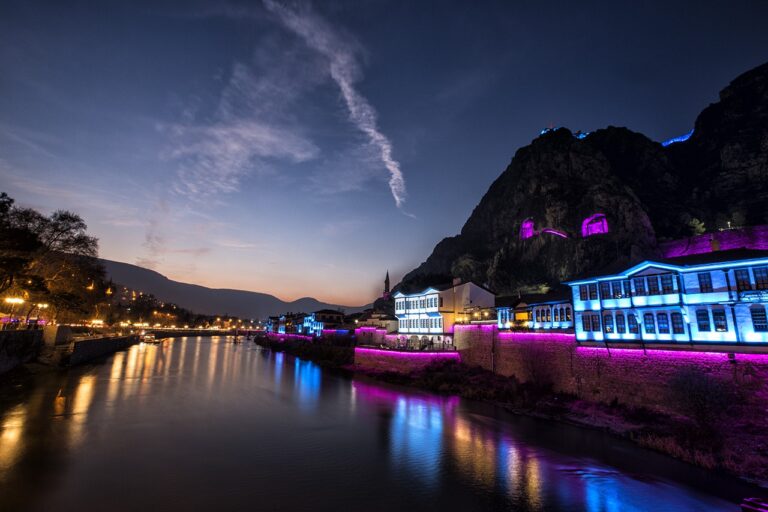Starting in the morning from Samsun, my train journey ending towards noon in Amasya, the “City of Princes,” where many Ottoman princes, including Murad II, Bayezid II, and Selim I, served as governors, led me to discover a different side of Anatolia. The cultural variations hosted by the city, from people frying and drying peppers to riding bicycles on dedicated bike lanes, were major motivators in shaping this perception. Beyond this, what excited me even more were the factors such as the city housing Turkey’s largest mummy collection – remnants from the Ilkhanate period – in its archaeology museum, and its historical texture that has preserved and renewed itself through various eras from the Hittites to the Seljuks and Ottomans, sometimes making one feel as if they are in Samarkand. Additionally, the fact that the city is home to the birth certificate of the Republic of Turkey is truly thrilling.

Among these, the tombs of the kings of the Kingdom of Pontus (281 BC – 63 AD), one of the Hellenistic states established on the southern coast of the Black Sea, which I had heard and read about while exploring Samsun but knew little about in terms of historical writing, particularly caught my attention. The area where the tombs are located is also home to the remnants of the Kızlar Sarayı (Palace of the Maidens), built by İsfendiyar Bey for his granddaughter Doğrak Hatun. This palace served Ottoman princes and governors for over 150 years, remained active until 1852, and was later left in ruins by time except for two baths.

Located in the Yeşilırmak Valley, the 18 tombs, some of which can be seen in similar structures along the roadside, include five that are situated on the southern slopes of Mount Harşena along with the Kızlar Sarayı. These tombs lost their courtyard columns during the Roman invasions but have since maintained their historical texture up to the present day. The tombs are designed in a “U” shape, with recesses around and an opening in the middle serving as the entrance, allowing for circumambulation. This structure suggests that the burial ceremonies of the Bronze Age inhabitants of the region continued. The ancient researcher Strabo from Amasya mentions that these royal tombs belonged to the Pontus Kings, who made Amasya their capital in the 3rd century BC.
The first of these kings was Mithridates I, who lived between 301 and 266 BC. His rock tomb features large beds that allowed for burial gifts and family interments and reflects his Persian ancestry. His son and the second Pontus King, Ariobarzanes, whose tomb is adjacent, is thought to have been deified, as indicated by the wide recess allowing for circumambulation. This tomb was converted into a chapel during the Byzantine period. The third tomb, belonging to Mithridates II, the third Pontus King, is located to the east of the site entrance and shares the same characteristics, including fresco traces indicating its conversion into a chapel and use as a refuge during the Byzantine period.
Due to the lack of a direct connection between the two areas, visitors must return to the entrance, passing by the Ottoman Baths remaining from the Kızlar Sarayı, and then walk west. Here, the first tomb encountered is that of Mithridates III, which reflects the continuity of the death worship tradition with similar structural features. The last tomb in the area belongs to Pharnakes I, the tomb started for this king was never completed due to the Roman invasion, and thus he was not buried there.
Like many museums and archaeological sites in Amasya, access to this site is not covered by the museum card and costs around 50 TL. Visitors should be prepared for a quite breathtaking climb up the stairs to reach the tombs.
Lastly, I wanted to give a small warning for those planning to visit Amasya. The Amasya Bus Terminal has been relocated outside the city, and the old bus terminal location within the city no longer reflects the current situation. Therefore, to avoid finding yourself staring at the new Medical Faculty building where the old bus terminal used to be, just 20 minutes before your bus departure, I recommend searching for “New Amasya Bus Terminal” when looking for its location.


